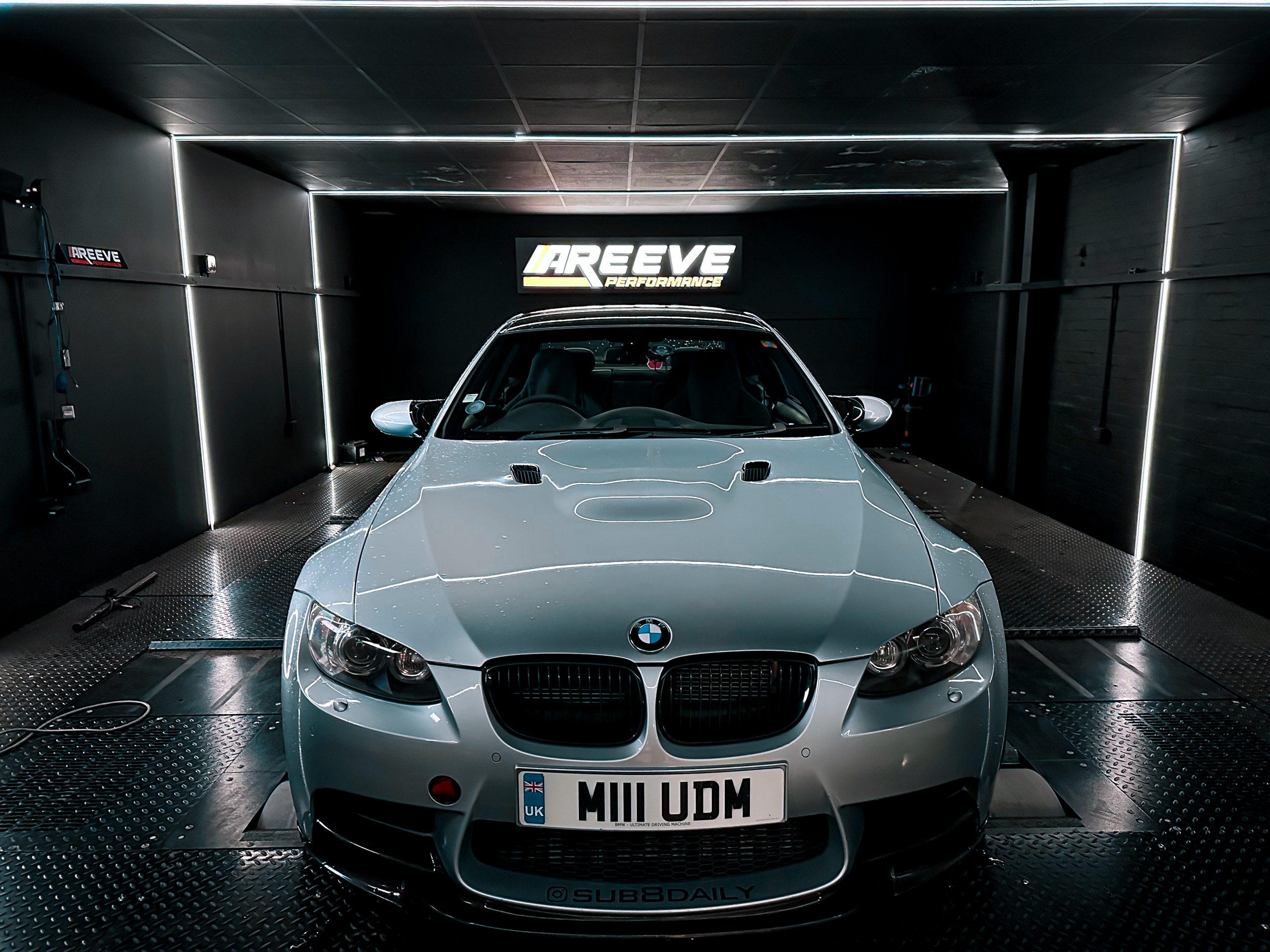MAHA Dyno Power Runs & Dyno Tuning

POWER RUN
This consists of carrying out a full throttle power test to determine bhp and torque at the wheels and calculated flywheel figures, at the same time where possible we will monitor boost and fuelling using exhaust gas analyzer and wideband lambda sensor we also have a external boost card to log boost where there isn’t available via OBD Our charge for a power run is £125 inc VAT.
FULL DYNO SESSION / DIAGNOSTICS
Checks are carried out to ignition operation, fuelling system, engine management fault codes and live data with adjustments being made where possible. We then carry out a full throttle power test to determine bhp and torque at the wheels and calculated flywheel figures. Also, at the same time where possible we will monitor boost and fuelling using exhaust gas analyser and wideband lambda sensor. Our Dyno diagnostic labour rate of £120 per hour plus VAT will apply. This is separate to the cost of the power run. Where diagnostics are required to fault find our diagnostic labour rate of £75 per hour plus VAT will apply. This is separate to the cost of the power run. Prior to commencing a dyno run you will be asked to review our terms and conditions
To book a session on our dyno please contact us via phone or email. For further details on our mapping services please click here.
ABOUT OUR DYNO
We put a lot of consideration into investing in our dyno We explored a number of the American dynos which are significantly more cost effective. If we had wanted to produce headline numbers or run dyno days then these dynamometers probably would have been perfect. We also looked at the Australian manufacturer Dyno Dynamics a popular choice amongst many tuners in the UK. Like the American models this type of dyno is designed to measure power at the wheels and then uses a fixed multiplier to calculate the flywheel figure that many of our UK customers demand. However it is not a calculation method we have ever really agreed with due to the large grey area that can be misleading. The Maha MSR500 dyno is the same as that installed at Porsche, VAG group, Toyota Motorsport and BMW M Power, amongst other key players in the manufacturing sector.
DYNO CELL
We were aware from the off that the performance of the dyno cell surrounding the dynamometer is every bit as important as the dyno itself, if the readings derived from the dyno are to be considered useful and accurate. With this in mind, we conducted considerable research to ensure we could achieve the best possible set-up. To avoid heat soak and high intake air temperatures that can falsify readings especially during live mapping we have had our fresh air supply engineered to our specific requirements. Fresh air is drawn from outside via fabricated inlet and pipework into our MAHA fan so real world driving is simulated with fresh external air rather than warm polluted air from within a workshop environment. Exhaust emissions are taken care of via exhaust extraction to outside of the building this enables are for our cell to be used completely self contained.
TIMED ACCELERATION RUNS
Another great feature to help us quantify an improvement is the ability to time acceleration between various points. The dyno can calculate how quickly the car will now accelerate from 30-130mph in 5th or 20-70mph in 3rd, all with real-world load applied to the car. Not only does the dyno record these times but it can display them as a league table. This table then gets constantly updated each time the car passes through these two points. If, for example, we wanted to improve the power between 5,000rpm-6,000rpm we can set this as a timed window and accelerate through with the benefit of not having to start loading the car up from low rpms. This avoids creating unnecessary heat build-up and enables us to just plant the throttle from the same point making the runs consistent. This is a great tool for us to get the calibration close during live mapping sessions.
BRAKED DYNO’S
Braked Dynamometers work in a totally different way to Inertia Dyno’s (where most internet explanations are derived). As the title suggests, the vehicle is driving against a “braked roller”, a “strain gauge”, is attached between the brake and the chassis to measure force. A speed sensor is also attached to the axle of the dyno to measure shaft speed. Force (at the measuring gauge) x Speed (at the axle) = Power. We call this power P-Wheel as that is the industry recognised term. In the case of a MAHA Dynamometer, once the peak power is attained, the clutch is depressed and the vehicle starts to “coast down”, during the “coast down”, phase, the Dyno measures loss “P-Loss”, starting at the measuring gauge, right back to the clutch plate. This loss is displayed and added to the “P-Wheel”, in order to show “PEng” (Crank power), this has been proved time and again to be the accurate measure of power.
Our dyno is also calibrated for accuracy every 12 months a copy of our calibration certificate is available.
Frequently Asked Questions
What is a Power Run and what does it involve?
A Power Run consists of a full throttle power test to determine bhp and torque at the wheels, as well as calculated flywheel figures. We also monitor boost and fuelling where possible, using an exhaust gas analyzer and wideband lambda sensor. The charge for a Power Run is £125 including VAT.
What does a Full Dyno Session/Diagnostics include?
This session involves checks to ignition operation, fuelling system, engine management fault codes, and live data, with adjustments made where possible. A full throttle power test is also conducted. The Dyno diagnostic labour rate is £120 per hour plus VAT, separate from the power run cost.
How do you calculate the flywheel power figures?
We use the Maha MSR500 dyno, which measures power at the wheels and then calculates the flywheel power figures. This method is more accurate than using fixed multipliers and avoids misleading grey areas.
Why did you choose the Maha MSR500 dyno over others?
The Maha MSR500 is used by major manufacturers like Porsche, VAG group, Toyota Motorsport, and BMW M Power. We chose it for its accuracy and reliability, over more cost-effective American models or the Australian Dyno Dynamics, which we believe are less accurate in calculating flywheel figures.
What makes your Dyno Cell special?
Our Dyno Cell is designed for optimal performance and accurate readings. It features a specifically engineered fresh air supply to avoid heat soak and high intake air temperatures, along with external exhaust extraction for a clean and controlled environment.
Can you do timed acceleration runs?
Yes, our dyno can time acceleration between various points, like 30-130 mph in 5th gear or 20-70mph in 3rd gear, under real-world load. We can even set specific rpm windows for targeted improvements during live mapping sessions.
How does a Braked Dynamometer work?
In a Braked Dynamometer, the vehicle drives against a braked roller. A strain gauge measures force, and a speed sensor measures shaft speed. The dyno calculates ‘P-Wheel’ (power at the wheel) and ‘P-Loss’ during coast down, which combined show ‘PEng’ (Crank power).
How often is your dyno calibrated?
Our dyno is calibrated for accuracy every 12 months. A copy of our calibration certificate is available upon request.
How do I book a session on your dyno?
To book a session, please contact us via phone or email. We’ll guide you through the process and schedule a convenient time for your session.
What are your terms and conditions for a dyno run?
Prior to commencing a dyno run, we ask clients to review our terms and conditions. This includes information about our service protocols, customer responsibilities, and any liability aspects.

